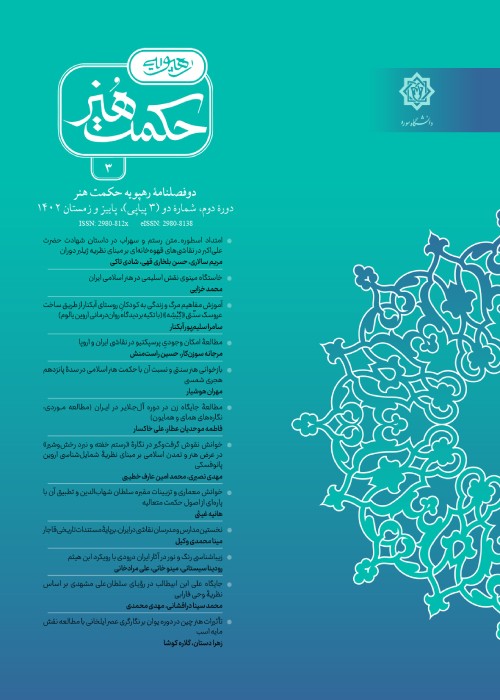Aesthetics of Color and Light in Iran Daroudi’s Works with Ibn al-Haytham’s Approach
Author(s):
Article Type:
Research/Original Article (بدون رتبه معتبر)
Abstract:
Aesthetics is a branch of philosophy whose subject is the nature of beauty and taste, as well as the philosophy of art (it has its own field of philosophy that emerges from aesthetics). Also, aesthetics is an ability to better understand perceptions, as well as hard phenomena such as sculpture and soft phenomena such as music. It causes a change in a person’s mood and attitude. Ibn Haytham’s approach is akin to an experimental mindset based on a profound understanding of Greek science and philosophy, as well as the rational observation of humanity’s connection with the natural world and physical laws. Ibn al-Haytham’s proposed approach beautifully relates to a complex phenomenon. He has studied this subject as both a physicist and a thinker, leading to the establishment of this connection. Visual perception occurs because the eye is made up of layers, coverings, and numerous parts; however, its main component is located in the front part of the brain. In the treatise “Al Manazar”, Ibn al-Haytham’s explanation of the vision process as a major and preliminary cognitive experience has a surprisingly phenomenological and psychophysical tone. This issue is especially evident when he proposes the theory of sensory perception of the beauty of objects of perception (Al-Hassan). This treatise initially proposes an important scientific statement about the physical process of vision as a result of the actions of light and color and he believes that according to two principles of beauty in objects, they differ from each other, firstly because of the characteristics or general visual characteristics of those that he introduces in a list, and these characteristics are the general structure of objects or the ground. They create them, which create beauty also for example, light in the list of these 22 factors (characteristics), is the first item that creates beauty, and that is why we consider the sun, the moon, and the stars to be beautiful things, while it should be noted that the sun, the moon, and the stars are what enhance their beauty. There is no way to make things beautiful or to give them a beautiful shape, everything that exists is because of their brilliance. Ibn al-Haytham’s theory of perception of beauty takes into account the qualities and visual structure necessary in the work of art. It is necessary to research the potential aspects of his theories in the field of aesthetics and visual structure. Iran Darudi gives an Iranian identity to his works with aesthetic elements, he made light the main goal to get closer to the ideas of Iranian culture and also uses light to induce the expression of his feelings so that the audience understands the concept of the artist’s sense and he has reached this conclusion. that no color is a color outside of the radiation of light, and the colors are only in proximity and influencing each other, which reveal their quality and color. Due to the structural nature of painting, whose aesthetics is based on principles that are completely consistent with the 22 cases in Ibn al-Haytham’s opinions, the purpose of this article is to examine these theoretical cases and how to apply them in the art of painting, and to answer the question of how the aesthetic theory of light and color from Ibn al-Haytham’s point of view can be He understood the modern principles of aesthetics in the Iranian works of Darudi, first, he describes and analyzes the nature and characteristics of Darudi’s works and then analyzes those works with Ibn Haitham’s opinions. This article whose theoretical method is based on Islamic philosophy theorist Ibn al-Haytham. In this aesthetic approach that deals with the form of the work, Ibn al-Haytham defines aesthetics as follows “He defined beauty (beauty) not as a simple factor, but as a complex interaction between twenty-two factors.” This is a very subtle point that Ibn al-Haytham defined only two of these factors, light and color (which itself is a property derived from light). They have motivational power, that is, they can create an effect in the soul that makes the face look beautiful. The research method is practical in terms of purpose and descriptive-analytical in terms of perspective, and the information is also obtained based on library studies. The research results show the efficiency of Ibn Haitham’s approach in the field of aesthetics of contemporary painting. By achieving a powerful and masterful technique, this artist has been able to draw the most delicate and delicate spiritual vibrations and her aesthetic attitude on the screen of her paintings.
Keywords:
Language:
Persian
Published:
Journal of Rahppoye, Hekmat-e Honar, Volume:2 Issue: 2, 2023
Pages:
117 to 124
magiran.com/p2680140
دانلود و مطالعه متن این مقاله با یکی از روشهای زیر امکان پذیر است:
اشتراک شخصی
با عضویت و پرداخت آنلاین حق اشتراک یکساله به مبلغ 1,390,000ريال میتوانید 70 عنوان مطلب دانلود کنید!
اشتراک سازمانی
به کتابخانه دانشگاه یا محل کار خود پیشنهاد کنید تا اشتراک سازمانی این پایگاه را برای دسترسی نامحدود همه کاربران به متن مطالب تهیه نمایند!
توجه!
- حق عضویت دریافتی صرف حمایت از نشریات عضو و نگهداری، تکمیل و توسعه مگیران میشود.
- پرداخت حق اشتراک و دانلود مقالات اجازه بازنشر آن در سایر رسانههای چاپی و دیجیتال را به کاربر نمیدهد.
In order to view content subscription is required
Personal subscription
Subscribe magiran.com for 70 € euros via PayPal and download 70 articles during a year.
Organization subscription
Please contact us to subscribe your university or library for unlimited access!


